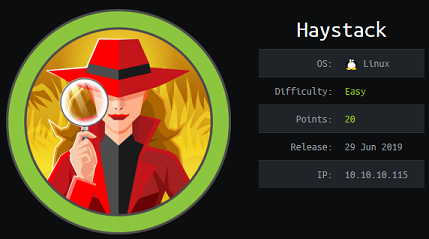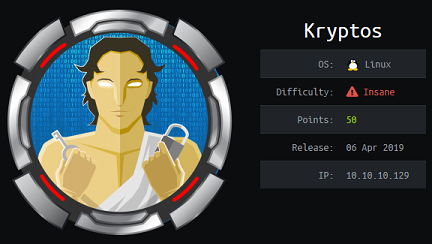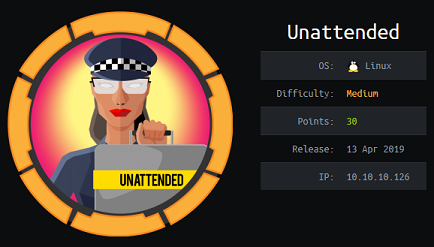Haystack - Hack The Box

 Haystack is an easy ctf-like box where the initial credentials can be found hidden in an ElasticSearch database. Knowing some ES API syntax it’s very easy to retrieve the credentials then get an SSH shell. After exploiting CVE-2018-17246 in Kibana, I get another shell with user kibana who has read access on the configuration for logstash which is running as root. The logstash configuration will run as root any command placed in a specific logstash directory/file so once I figured that out it was easy to get a root shell.
Haystack is an easy ctf-like box where the initial credentials can be found hidden in an ElasticSearch database. Knowing some ES API syntax it’s very easy to retrieve the credentials then get an SSH shell. After exploiting CVE-2018-17246 in Kibana, I get another shell with user kibana who has read access on the configuration for logstash which is running as root. The logstash configuration will run as root any command placed in a specific logstash directory/file so once I figured that out it was easy to get a root shell.
 Safe was a bit of a surprise because I didn’t expect a 20 points box to start with a buffer overflow requiring ropchains. The exploit is pretty straightforward since I have the memory address of the system function and I can call it to execute a shell. The privesc was a breeze: there’s a keepass file with a bunch of images in a directory. I simply loop through all the images until I find the right keyfile that I can use with John the Ripper to crack the password and recover the root password from the keepass file.
Safe was a bit of a surprise because I didn’t expect a 20 points box to start with a buffer overflow requiring ropchains. The exploit is pretty straightforward since I have the memory address of the system function and I can call it to execute a shell. The privesc was a breeze: there’s a keepass file with a bunch of images in a directory. I simply loop through all the images until I find the right keyfile that I can use with John the Ripper to crack the password and recover the root password from the keepass file.
 Writeup starts off easy with an unauthenticated vulnerability in CMS Made Simple that I exploit to dump the database credentials. After cracking the user hash, I can log in to the machine because the user re-used the same password for SSH. The priv esc is pretty nice: I have write access to /usr/local and I can write a binary payload in there that gets executed by run-parts when I SSH in because it’s called without the full path. Another nice box by jkr.
Writeup starts off easy with an unauthenticated vulnerability in CMS Made Simple that I exploit to dump the database credentials. After cracking the user hash, I can log in to the machine because the user re-used the same password for SSH. The priv esc is pretty nice: I have write access to /usr/local and I can write a binary payload in there that gets executed by run-parts when I SSH in because it’s called without the full path. Another nice box by jkr.
 Ghoul was a tricky box from Minatow that required pivoting across 3 containers to find the bits and pieces needed to get root. To get a shell I used a Zip Slip vulnerability in the Java upload app to drop a PHP meterpreter payload on the webserver. After pivoting and scanning the other network segment I found a Gogs application server that is vulnerable and I was able to get a shell there. More credentials were hidden inside an archive file and I was able to use the root shell on one of the container to hijack the SSH agent socket from a connecting root user and hop onto the host OS.
Ghoul was a tricky box from Minatow that required pivoting across 3 containers to find the bits and pieces needed to get root. To get a shell I used a Zip Slip vulnerability in the Java upload app to drop a PHP meterpreter payload on the webserver. After pivoting and scanning the other network segment I found a Gogs application server that is vulnerable and I was able to get a shell there. More credentials were hidden inside an archive file and I was able to use the root shell on one of the container to hijack the SSH agent socket from a connecting root user and hop onto the host OS.
 SwagShop is one of those easy boxes where you can pop a shell just by using public exploits. It’s running a vulnerable Magento CMS on which we can create an admin using an exploit then use another one to get RCE. To privesc I can run vi as root through sudo and I use a builtin functionality of vi that allows users to execute commands from vi so I can get root shell.
SwagShop is one of those easy boxes where you can pop a shell just by using public exploits. It’s running a vulnerable Magento CMS on which we can create an admin using an exploit then use another one to get RCE. To privesc I can run vi as root through sudo and I use a builtin functionality of vi that allows users to execute commands from vi so I can get root shell.
 I loved the Kryptos machine from Adamm and no0ne. It starts with a cool parameter injection in the DSN string so I can redirect the DB queries to my VM and have the webserver authenticate to a DB I control. Next is some crypto with the RC4 stream cipher in the file encryptor web app to get access to a protected local web directory and an LFI vulnerability in the PHP code that let me read the source code. After, there’s an SQL injection and I use stacked queries with sqlite to gain write access and RCE by writing PHP code. After finding an encrypted vim file, I’ll exploit a vulnerability in the blowfish implementation to recover the plaintext and get SSH credentials. For the priv esc, I pop a root shell by evading an eval jail in a SUID python webserver and exploiting a broken PRNG implementation.
I loved the Kryptos machine from Adamm and no0ne. It starts with a cool parameter injection in the DSN string so I can redirect the DB queries to my VM and have the webserver authenticate to a DB I control. Next is some crypto with the RC4 stream cipher in the file encryptor web app to get access to a protected local web directory and an LFI vulnerability in the PHP code that let me read the source code. After, there’s an SQL injection and I use stacked queries with sqlite to gain write access and RCE by writing PHP code. After finding an encrypted vim file, I’ll exploit a vulnerability in the blowfish implementation to recover the plaintext and get SSH credentials. For the priv esc, I pop a root shell by evading an eval jail in a SUID python webserver and exploiting a broken PRNG implementation.
 Luke is a easy machine that doesn’t have a lot steps but we still learn a few things about REST APIs like how to authenticate to the service and get a JWT token and which headers are required when using that JWT. The rest of the box was pretty straighforward with some gobuster enumeration, finding PHP sources files with credentials then finally getting a shell through the Ajenti application.
Luke is a easy machine that doesn’t have a lot steps but we still learn a few things about REST APIs like how to authenticate to the service and get a JWT token and which headers are required when using that JWT. The rest of the box was pretty straighforward with some gobuster enumeration, finding PHP sources files with credentials then finally getting a shell through the Ajenti application.
 Bastion was an easy box where we had to find an open SMB share that contained a Windows backup. Once we mounted the disk image file, we could recover the system and SAM hive and then crack one of the user’s password. An OpenSSH service was installed on the machine so we could SSH in with the credentials and do further enumeration on the box. We then find a mRemoteNG configuration file that contains encrypted credentials for the administrator. The system flag blood was still up for grab when I reached that stage so instead of reversing the encryption for the configuration file I just installed the mRemoteNG application on a Windows VM, copied the config file over and was able to log in as administrator.
Bastion was an easy box where we had to find an open SMB share that contained a Windows backup. Once we mounted the disk image file, we could recover the system and SAM hive and then crack one of the user’s password. An OpenSSH service was installed on the machine so we could SSH in with the credentials and do further enumeration on the box. We then find a mRemoteNG configuration file that contains encrypted credentials for the administrator. The system flag blood was still up for grab when I reached that stage so instead of reversing the encryption for the configuration file I just installed the mRemoteNG application on a Windows VM, copied the config file over and was able to log in as administrator.
 OneTwoSeven starts with enumeration of various files on the system by creating symlinks from the SFTP server. After finding the credentials for the ots-admin user in a vim swap file, I get access to the administration page by SSH port-forwarding my way in and then I have to use the addon manager to upload a PHP file and get RCE. The priv esc was pretty fun and unique: I had to perform a MITM attack against apt-get and upload a malicious package that executes arbitrary code as root.
OneTwoSeven starts with enumeration of various files on the system by creating symlinks from the SFTP server. After finding the credentials for the ots-admin user in a vim swap file, I get access to the administration page by SSH port-forwarding my way in and then I have to use the addon manager to upload a PHP file and get RCE. The priv esc was pretty fun and unique: I had to perform a MITM attack against apt-get and upload a malicious package that executes arbitrary code as root.
 Unattended was a pretty tough box with a second order SQL injection in the PHP app. By injecting PHP code into the web server access logs through the User-Agent header, I can get RCE by including the logs using the SQL injection. I didn’t quite understand what the priv esc was about though. I found the initrd archive and stumbled upon the contents by doing a grep on the box author’s name.
Unattended was a pretty tough box with a second order SQL injection in the PHP app. By injecting PHP code into the web server access logs through the User-Agent header, I can get RCE by including the logs using the SQL injection. I didn’t quite understand what the priv esc was about though. I found the initrd archive and stumbled upon the contents by doing a grep on the box author’s name.